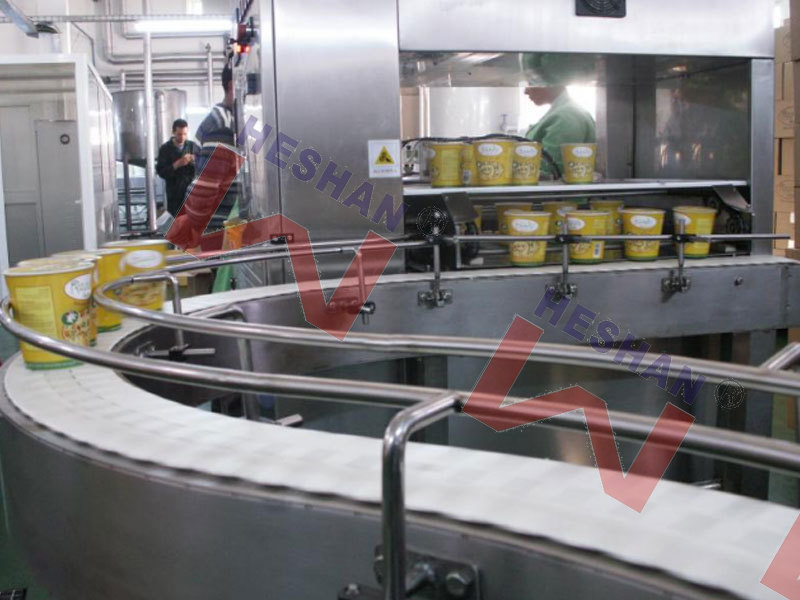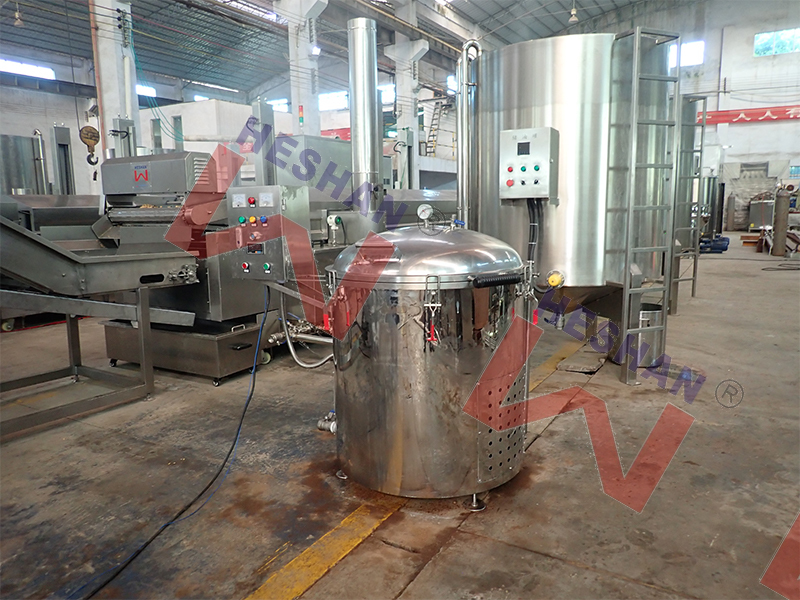Theory and practice of rice vermicelli and vermicelli production
China is a big producer of rice noodles and vermicelli, and it is also a big consumer. In the long-term production practice, many production enterprises have accumulated rich practical experience, providing a wide range of rice noodles and vermicelli products for consumers with different needs, basically meeting the needs of the market. On the other hand, China's academic circles are very concerned about the theories related to the production of rice noodles and vermicelli, and while introducing the relevant theoretical research results of foreign academic circles, they also carry out research and discussion on relevant theories, and guide individual production enterprises to achieve results.
Theoretical research and experiments related to the production of rice noodles and vermicelli, China's academic circles focus on the gelatinization and aging of starch. Since most of the research in academia is carried out in laboratory conditions, the results and discourses obtained are often not in line with the practice under the influence of complex factors in production. Most of the technicians and production workers of rice noodles and vermicelli enterprises have found and learned many practical problems and phenomena in production, and have also found some effective countermeasures, but due to the lack of scientific basic theories, they have not been able to give full play to the role of theory in guiding practice, and even have gone into misunderstandings and taken detours, which is not conducive to the development of production enterprises.
In view of the above situation, production enterprises should master the basic theoretical knowledge of rice noodles and vermicelli production, so as to correctly and effectively solve difficult problems in production; Academics should go deep into reality and select more topics that have a large relationship between production and are highly targeted for scientific and theoretical research. Only in this way can we realize the combination of scientific theory and production practice, transform scientific research achievements into productive forces, and let academia and industry promote each other and form a win-win cooperation pattern.
1.Gelatinization
Grains, potatoes, corn or some legumes are the main raw materials for the production of rice flour and vermicelli. Starch is the main component of these raw materials, so the maturation of rice flour and vermicelli is basically the maturation of the starch contained in them. Academics refer to this process as gelatinization, also known as gelatinization, or α for short. There are various methods for manufacturers to realize the gelatinization of rice noodles and vermicelli, including the so-called "boiled", "steamed powder", "steamed sheets", "steamed grains", "high temperature stirring", "pressure steamed powder", "re-steaming", "squeezing self-cooking", "steamed rice" (used in Yunnan bait silk and other products) and so on.
Starch is insoluble in water at room temperature, and stirring with water can form a uniform suspension. The water molecules only enter the amorphous part of the starch granules, that is, the starch granules absorb a small amount of water, and the volume expands slightly, but does not affect the crystal structure within the starch granules, and the properties of the starch remain unchanged. If the water entering the granules is dried and removed at room temperature, the original properties of the starch can be restored, so this process is called the reversible water absorption stage of starch. When the starch suspension is heated by heat, the water molecules begin to enter the crystallization area of the starch granules, and some chemical bonds between the starch molecules become unstable. With the breaking of these chemical bonds, the crystalline area in the starch granules changes from the original tightly arranged state to a loose state, so that the water absorption of starch increases rapidly, and the volume of the granules expands sharply. This is an irreversible process of water absorption that cannot be reversed. When further heated and heated, the starch granules continue to absorb water and expand until the granules burst. The molecules in the particles stretch and spread to all directions, and the molecules will be connected and entangled with each other to form a network of aqueous colloids, which completes the gelatinization process of starch.
As we can see from the process of gelatinization, gelatinization has a temperature range. The temperature at which the birefringence phenomenon begins to disappear is called the initial gelatinization temperature, and the temperature at which the birefringence phenomenon completely disappears is called the complete gelatinization temperature. For the same starch, the high amylose content will have a high gelatinization temperature; The starch granules are small, and the gelatinization temperature will be higher. The gelatinization of starch depends on the temperature achieved and the amount of water that can be absorbed during gelatinization. The gelatinization temperature of the same type of starch increases when the amylose content is high; When the starch granules are larger, the gelatinization temperature decreases.
In the production practice of rice noodles and vermicelli, there are many gelatinization methods, and the conditions are more complicated. In general, rice noodles and vermicelli gelatinized by boiling or steaming slices can be fully gelatinized; Extruded rice noodles and vermicelli, no matter what gelatinization method is used, most of them are incomplete. In order to improve its gelatinization, some manufacturers have noticed the importance of increasing the water content of the gelatinization of work-in-progress. The production process of cross-bridge rice noodles (brewed dry products), which was once all the rage, is squeezed and gelatinized once, and the spit rate is very high when the product is eaten. Many companies have increased the extrusion power and increased the heating device to improve its gelatinization, but the result is very little. The reason for this is that the main role played by the water content of the extruded gelatinized powder is not fully understood. After testing, the temperature of the dough in the extrusion self-ripening machine barrel can reach more than 90 ℃, which is much higher than the gelatinization temperature of rice starch, while the water content of the dough only reached 37~38% in the early years, and later increased to 40~42%, which significantly reduced the slurry rate of the product when rehydrating. There is a cross-bridge rice noodle enterprise in Shenzhen, which uses a special process to make the water content of the dough reach 44% during gelatinization, and the slurry rate of its product when rehydrated is the lowest among similar products.
The production of instant sweet potato vermicelli and potato vermicelli mostly adopts the process of extrusion and self-cooking, but the water content during gelatinization is 53~55%, so its gelatinization degree is relatively high. The water content of instant rice flour and corrugated rice flour is generally only 37~40% when gelatinized, although it is gelatinized under atmospheric pressure twice, the gelatinization degree is low. Practice shows that no matter what gelatinization method is used, when the water content is less than 50% during gelatinization, it is difficult to achieve complete gelatinization under atmospheric pressure. In dry rice flour products, rice flour is almost completely gelatinized, and its gelatinization degree is relatively high in extruded products. It undergoes two gelatinizations: the first is stirring at high temperature at atmospheric pressure (steam is introduced during the mixing of the dough); The second time is to put the vermicelli into a steam pressure vessel after aging, and steam the vermicelli at a pressure of 0.113~0.116Mpa (absolute pressure) for 30~40 minutes. This product has a very low spitting rate when cooked. More than 10 years ago, the spitting rate of Jiangxi straight rice noodles was lower than today's products. The reason is that in order to reduce the difficulty of vermicelli bonding and ease filament, pressure gelatinization only lasts a few minutes, and the water content of the extruded vermicelli is only 33~35% (the water content of individual manufacturers when the vermicelli is aged). Therefore, the gelatinization degree of today's straight rice noodles is very low, and the spitting rate is high when cooking. In addition, rice with a high amylose content (more than 24%) is mostly used as a raw material in rice flour production, while starch with high amylose content has a higher gelatinization temperature and is not easy to gelatinize.
Flat rice noodles (commonly known as fresh rice noodles) and potato noodles are mostly gelatinized in the form of steamed sheets. The water content of the material is more than 58% when steaming, so the gelatinization degree is high, and there is very little paste soup when cooking. The gelatinization degree of boiled rice noodles and vermicelli is very high, because there is enough water for starch granules to absorb water and expand until the granules are broken, so as to achieve a relatively complete gelatinization. Such products include boiled fresh wet rice noodles, fresh-keeping rice noodles, wrasse noodles, Longkou vermicelli and Yunnan traditional fresh wet cross-bridge rice noodles.
Although boiled rice vermicelli gelatinizes well, the moisture content of the final product is not easy to control, and the water content has a great impact on the quality of fresh rice flour and fresh-keeping rice flour. The water content of the product in the boiled gelatinization process usually varies in the range of 63~70%. Better quality products usually control their water content to be 64~65% (this water content is difficult to control), and about 2.5kg of products can be produced for every 1kg of dry raw materials. If the boiling time and temperature fluctuate slightly, the water content will change greatly. For economic reasons, some manufacturers have a water content of 70% (this water content is easier to control), and about 2.9kg of product can be produced for every 1kg of dry raw material.
Generally speaking, the heating temperature of starch raw materials in the gelatinization process of rice vermicelli production is much higher than the complete gelatinization temperature. Because the water content of starch in the gelatinization process of many dry products is generally low, these products cannot be completely gelatinized, and the spitting rate is high during cooking. Improving the gelatinization degree can not only reduce the slurry rate of the product, but also improve the eating quality of the product to a certain extent. However, to improve the gelatinization degree, it is necessary to increase the water content of the raw starch gelatinization, which will make the vermicelli more cohesive and difficult to loosen in the production process, and there will be many difficulties that are not easy to solve in production. This is the accumulation of experience in the long-term production of rice noodles and vermicelli in China, and between the gelatinization degree and the spewing rate, it has found a balance that is acceptable to both consumers and producers. Then we must improve and move forward, and we will enter the deep water area of combining theory and practice, which requires the cooperation between academia and production enterprises.
2. Retrogradation / Aging
The starch molecules that have been dissolved and expanded during starch gelatinization are quickly rearranged and combined in a limited area after cooling, and the solubility of the molecules is reduced when the linear molecules are associated, and gradually become insoluble in water like natural starch. This process is called retrogradation, also known as regeneration, referred to as β; In order to facilitate communication with foreign companies, the technical community calls it aging; The master of the production enterprise calls it spreading, cooling silk, turning and so on. In recent years, manufacturers have also begun to call it aging.
Aging is the reverse process of gelatinization, but aging is irreversible and cannot be restored to the pre-aging state through gelatinization.
Many foods made from starchy raw materials become hard after aging, which affects the taste. Most of the academic research on starch aging focuses on anti-aging research. In rice noodle and vermicelli production enterprises, most of the dry products are required to accelerate aging in the production process, and only fresh wet rice noodles, especially fresh-keeping rice noodles with a long shelf life, need anti-aging treatment.
There are two main factors that affect the aging rate of vermicelli and vermicelli, that is, the moisture content of rice noodles and vermicelli during aging and the temperature during aging. The faster the aging rate, the shorter the time to complete the aging. Other factors also play a role, such as products with high amylose content are more susceptible to aging, and products with more acidic and alkaline content age slowly.
Aging is divided into short-term aging and long-term aging. Short-term aging generally refers to the time it takes to complete aging from tens of minutes to more than ten hours. In the production of rice noodles and vermicelli, most of them are short-term aging. Only fresh products with a moisture content of more than 60% (whose shelf life is more than half a year) need to be aged for a long time and need anti-aging treatment.
It is easy to age when the water content of the product in process is 30~60%, and the aging speed is the fastest when the water content is 40~45%. Aging is very slow when the water content is less than 30% or above 60%; There must be a free water village for starch aging, so when the water content is less than 10~13%, it basically stops aging.
Another important factor is the aging temperature. When it is below -18℃~-20℃ and above 60℃, starch will not age. Experiments show that the aging rate is the fastest at 2℃~4℃, so the lower the aging temperature, the easier it is to age, and the aging is slow when it is higher than 40℃.
For a long time, China's rice noodle and vermicelli production enterprises have basically relied on the accumulation of practical experience to establish production processes and configure production equipment. On the one hand, this has created a huge industry of diversification and specialization of rice noodles and vermicelli products in China. On the other hand, due to the lack of scientific theoretical cognition that only values practical experience, it is inevitable to take some detours or even go into misunderstandings, especially in the aging of rice noodles and vermicelli. For example, it is a misconception that the production of Dongguan rice noodles often involves a long cooling process before entering the dryer. The essence is an aging process. Since it is mistaken for cooling, the reduction of moisture in rice noodles will not be considered on the equipment, resulting in slow aging and poor results. There is a "puzzling" small process in the aging process of Jiangxi straight rice noodle production. In the first aging of rice noodles for about 8 hours, steam is sprayed into the aging machine for nearly an hour to heat up the noodles, and the maximum temperature can reach more than 60°C. Theoretically, rice flour has stopped aging at 60°C, which is about the initial gelatinization temperature of rice starch. Therefore, to classify this process as aging is contrary to the mechanism of aging. However, practice has proved that if the steam is not injected at the beginning of aging and the temperature in the machine rises to 60 °C, the aging is not good, and it cannot produce qualified products. After analysis, it is not that the theory of the aging mechanism is wrong, but because the moisture of the vermicelli is too low, the aging speed is slow, and the aging effect is not good. It has been found in practice that if steam is introduced during aging, after enough time (due to the introduction of steam, the temperature will naturally rise), the water content of vermicelli increases, and it becomes easy to age, so that the aging effect in the later stage becomes better. At present, the water content of Jiangxi straight rice noodles after extrusion is generally 33~35%, the temperature of vermicelli is higher when extruded, and the water is easy to evaporate, after a period of transfer time, the water content of vermicelli is lower, close to 30% of the water content that is not easy to age, and the effect of aging cannot be achieved. The solution is to increase the water content of the vermicelli, and the easier and more effective way is to increase the water content of the vermicelli directly with steam. It is a misconception to call this process aging.
Theoretically, the aging temperature can accelerate the aging of vermicelli, but some masters of rice noodle production enterprises in southern China do not fully agree. According to their practical experience, whenever the cold north wind blows in winter, the temperature is very low, but it cannot speed up the aging of rice noodles, but the aging fails, and the qualified products cannot be produced. This is the producer ignoring the effect of water content on aging and drawing the wrong conclusion. The water content of rice flour is generally 37~39%, the water evaporation of the hot vermicelli is faster, if the north wind blows, the air temperature is lower, but the relative humidity of the air is particularly low, the vermicelli is more likely to lose moisture, when the vermicelli moisture drops to the extent that it is difficult to age, the effect of low temperature is conducive to aging does not work, not that the theory and practice of low temperature are easy to age.
On the aging of rice noodles and vermicelli, there are also some successful examples of combining theory and practice. Many years ago, there was a problem in producing sweet potato vermicelli with steamed chips. Due to the large viscosity of the gelatinized powder, it is easy to be damaged by manual handling, and the aging time takes 5~6 hours, which is difficult to achieve continuous automatic mechanized production. According to the aging mechanism with the fastest aging rate at a temperature of 2~4 °C after starch gelatinization, the aging time is shortened to 1.5 hours by continuous low temperature (3~5 °C) after steaming, and continuous automatic production is realized. This low-temperature aging technology was exported to Japan Acecook Company in Viet Nam for the production of steamed sheet flat rice noodles (commonly known as rice noodles), shortening the original aging process of 7~8 hours to only 1.5~2 hours. Later, it was also used for the aging of extruded rice noodles, and the aging temperature was increased to 10~12 °C in order to save energy, which also greatly shortened the aging time.
Another anti-aging method is to flash freeze rice flour with high water content after gelatinization to -18~-20 °C. According to theoretical research, flash freezing causes the rapid crystallization of water between starch molecules, resulting in the difficulty of hydrogen bond binding and delaying aging. There is a production enterprise of fresh-keeping rice flour in Los Angeles, United States, which uses the method of flash freezing to resist aging and extend the shelf life of the product.
What needs to be anti-aging is fresh-keeping rice noodles with a long shelf life (more than half a year). Although it has a water content of about 65% and ages slowly, after long-term slow aging accumulation, the vermicelli will become hard, easy to break, and have a poor taste. Therefore, fresh-keeping rice noodles must be treated with anti-aging. Most of them use β-amylase as an anti-aging agent for fresh-keeping powder. In practical application, the anti-aging agent should be evenly sprayed on the powder sheet, and moisturized at a temperature of 60°C~70°C for about 30 minutes. This requires specialized anti-aging equipment.
3. Advantages and disadvantages of dry and semi-dry methods
There are three ways to make rice into powdered small granules: wet, dry and semi-dry. The wet method is to soak rice and then add water to grind it into rice milk; The dry method is to directly crush the dry rice by impacting it; The semi-dry method is to soak the rice in water and then crush it. Only wet and semi-dry processes are actually used in production. For a long time, out of simplicity and habit, production enterprises have called the semi-dry method a dry method. Now the wet process and dry process are analyzed and compared according to the habits of enterprises.
In the production of rice noodles, straight rice noodles are produced by the dry process, and most other products are mostly produced by the wet process. Opinions differ as to which method is best. In the past, the production of rice flour in Guangdong was made by wet method and dry method. Most of the old Xingzun believe that the powder produced by the wet process is smaller, and the vermicelli is more "smooth" and of better quality. No valid scientific evidence has been found for this conclusion. The manufacturer believes that the rice flour particles of the wet process are smaller than those of the dry process, which is not completely consistent with the facts, and in fact, the wet powder particles obtained by refining are also of different sizes. In the past, most of the wet process could only use 40 mesh sieve slurry, and the particle size was not very small, while the dry production with micro pulverizer would have a finer particle size. Lao Xingzun of the manufacturer believes that the quality of the product is "smooth" because of the taste, which is different from the conclusion that some experiments in the academic community believe that small starch granules will slightly increase the toughness of the vermicelli. In fact, large starch granules are easier to gelatinize than small granules, which is conducive to improving product quality. If the statement that the quality of the products produced by the wet process is better, it is likely that the water content of the wet rice flour (37~38%) is higher than that of the dry production after refining and dehydration, which is conducive to gelatinization and aging, and there will be a slight difference in quality. Overall, dry production is better than wet production. In the process of refining and dehydration, the wet process should lose 1~2% more rice raw materials; The amount of sewage treatment generated by the wet process is large, and the investment and treatment cost of sewage treatment equipment should be increased. These issues have a direct and significant bearing on production enterprises. Whether to convert most of the wet production to dry production is up to the joint research of industry and academia to find out scientific conclusions.
In general, the production of rice noodles and vermicelli needs the guidance and support of scientific theories; Production practice is conducive to the refinement and deepening of theoretical research. The cooperation between academia and production enterprises will surely bear fruit.
Recommended
Innovation is tough, but there is a way out









